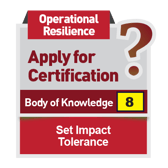Certification Application: Using Operational Resilience Body of Knowledge 8 (OR BoK 8) as part of your experience justification

 This guide showcases how to effectively utilize Operational Resilience Body of Knowledge 8 (OR BoK 8) within your "Implement" Phase 2 - Set Impact Tolerance Stage 3" P2-S3 experience justification for the certification application.
This guide showcases how to effectively utilize Operational Resilience Body of Knowledge 8 (OR BoK 8) within your "Implement" Phase 2 - Set Impact Tolerance Stage 3" P2-S3 experience justification for the certification application.
 Remember, OR BoK 8 outlines the minimum expected capabilities for an OR professional.
Remember, OR BoK 8 outlines the minimum expected capabilities for an OR professional.
Demonstrating Your Expertise
 Ensure that the "Set Impact Tolerance" content is included in your application. Click the icon on the right to recap.
Ensure that the "Set Impact Tolerance" content is included in your application. Click the icon on the right to recap.
This is a brief explanation of the template provided in the certification application form (CAF)
|
Evidence of Work Done |
[3] When was it done? MM-YYYY to MM-YYYY |
|
| [1] What was performed? Per the specific OR BoK? |
Detail the particular operational resilience practices you implemented. This is in line with the content of the OR BoK that you learned during the course. (Estimate of a minimum of 200 words) |
|
| [2] How was it carried out? |
This is a write-up of your actual implementation and contribution to the specific OR BoK within your organisation. You must demonstrate the completion of these particular OR practices. (Estimate of a minimum of 200 words) |
Please elaborate on the duration of the OR BoK. Was it over three years for ORCE and over one year for ORCS? |
In addition, here's how you may want to consider the following when describing your content: What was performed? and How was it carried out?
- Contextualize: Briefly establish the specific project or organization where you applied the principles.
- Map stages to experience: Link each step in "Set Impact Tolerance" to a concrete example from your work. Please refer to the "Areas of Expertise for OR BoK 8 "below.
 Provide evidence: Support your claims with tangible evidence, such as:
Provide evidence: Support your claims with tangible evidence, such as:
- Documents: Name (title and brief description) of reports, policy, proposal to management, and project plans.
- Testimonials: References from colleagues or project stakeholders.
- Quantify duration: Mention your time at each stage, highlighting your dedicated engagement. Remember to aggregate the duration to at least one year for the specialist level and three years for Expert-level application.
- Go beyond the minimum: While meeting specific standards of BoK expectations is essential, demonstrate how you exceeded them by adding further value. Did you develop innovative approaches? Did you lead a team through the process? Share such advancements to showcase your initiative and leadership.
Areas of Expertise for OR BoK 8 [P2-S3]
Remember:
The goal is to clearly understand how your organization defines and manages acceptable disruption levels for critical services. Use specific examples and metrics to showcase your knowledge and ability to apply these concepts.
By following these steps and mastering the terminology, you'll be well-equipped to tackle the "Set Impact Tolerance" section of your certification application confidently!
More Information About Blended Learning OR-5000 [OR-5] or OR-300 [OR-3]
To learn more about the course and schedule, click the buttons below for the OR-3 Blended Learning OR-300 Operational Resilience Implementer course and the OR-5 Blended Learning OR-5000 Operational Resilience Expert Implementer course.
 |
 |
 |
 |
 |
![[BL-OR] [3-4-5] View Schedule](https://no-cache.hubspot.com/cta/default/3893111/d0d733a1-16c0-4b68-a26d-adbfd4fc6069.png) |
![[BL-OR] [3] FAQ OR-300](https://no-cache.hubspot.com/cta/default/3893111/f20c71b4-f5e8-4aa5-8056-c374ca33a091.png) |
 |
|
 |
 |




![Email to Sales Team [BCM Institute]](https://no-cache.hubspot.com/cta/default/3893111/3c53daeb-2836-4843-b0e0-645baee2ab9e.png)


